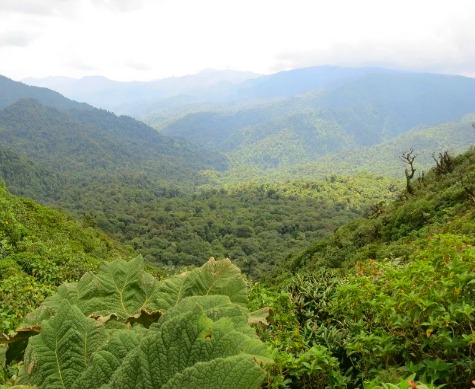7 Reasons Costa Rican Coffee Is Worth Traveling to Taste
 Costa Rica: a paradise teeming with wildlife, powdery beaches, and a philosophy that strives to protect their ecological wealth. Often, though, one of its biggest gifts to the world is overlooked: coffee.
Costa Rica: a paradise teeming with wildlife, powdery beaches, and a philosophy that strives to protect their ecological wealth. Often, though, one of its biggest gifts to the world is overlooked: coffee.
For those who want a refined coffee experience, look no further than Costa Rica. Still not convinced? Here are 7 reasons Costa Rican coffee is enough reason to visit.
1. Costa Rican Coffee Has a Rich History
“What is costa Rica known for?” Let’s save you a Google search: it’s their Arabica coffee.
Back in the 1700s, the first Arabica crops were brought from Ethiopia and it wasn’t soon until the government realized coffee’s potential and offered free land to anyone who wanted to farm it.
By 1829, coffee became one of Costa Rica’s most profitable exports that even overtook sugar, cacao, and tobacco.
2. Their Coffee is Regulated – Only Good Beans Allowed!
Wonder why Costa Rican coffee so good? Because, thanks to a law in 1989, the government made it illegal to produce any other coffee than Arabica – the highest quality of coffee beans.
Arabica beans are special because they’re more difficult to grow. This means when we sip their premium blend, we’re gifted with a full-bodied flavor. So, as Costa Rica only produces the best, it means you’ll be in coffee-lover heaven.
3. Perfect Coffee Climate
Arabica coffee beans are delicate and need the perfect climate to thrive. Enter Costa Rica.
With its mountainous regions and warm temperatures, farmers can harvest the highest-quality Arabica beans. Over 70% of Costa Rica’s coffee grows in the mountainous area thanks to its highly varied altitudes.
It’s also important to note that Costa Rica has two seasons, dry and rainy, which both maximize coffee growth. The temperature stays between 63 degrees Fahrenheit and 80 degrees Fahrenheit.
All these factors contribute to the coffee’s aroma, body, flavor, and acidity. Heck, even the soil is imbued with volcanic ash that helps oxygenate the beans and give them a richer flavor!
4. Sustainable Coffee-Picking Process
One reason Costa Rica coffee beans surpass the rest is that they’re hand-picked. Not only does this keep the beans in top condition, but coffee makers know when the beans are ready to be processed.
The farmers don’t pick every bean at once, they take time with their growing process and wait for the beans to mature to guarantee the best flavor. Collectors fill around 15 baskets a day before they are taken to processing plants to be washed and sorted. You’ll notice the best berries as they sink to the bottom.
The higher quality beans are de-husked, de-pulled, and are extracted. They’re then loaded into a round barrel which separates larger beans from smaller, before they are dried by sun or machine, and sent to be brewed just for you.
Costa Rica has many coffee plantations where you can see first-hand the process and enjoy a fresh cup of joe, there and then.
5. Great Way to Drink In the Culture
Did you know Costa Ricans make their coffee through a sock?
Well, a “corridor” which is a wooden stand with a cloth “sock” for the filter. This is how locals traditionally made their coffee and it’s the cloth filter that gives the coffee a richer flavor. This is because the sock retains more flavor and doesn’t produce a plastic after taste.
A classic cup of Costa Rican coffee is mild and softly acidic. Milk is often added after the coffee is brewed and it’s great to see how integral coffee is to the locals.
You can even pick up your own filter and frame from a Costa Rican coffee shop so you can show your loved ones how to enjoy a cup of coffee – Costa Rican style.
6. Deemed the Best Coffee in the World
In 2012, Costa Rican coffee became the most expensive coffee sold in American Starbucks stores. Customers went crazy for it and forked out $7 per cup and $40 a bag. In some stores, the coffee sold out in less than a day.
So it makes sense that Costa Rica is the world’s 13 largest producer of coffee and produces over 1.5 million bags each year. And 90% of those bags are exported.
The numbers alone show that Costa Rican coffee is some of the best in the world. So why not experience it first-hand and discover more about Costa Rica’s fine produce?
7. 8 Coffee-Growing Regions
Not sure where to find the best Costa Rican coffee in the country?
Don’t worry, you’ve got 8 regions jam-packed with tasting opportunities. You’ll find Central Valley produces a balanced cup of coffee with hints of chocolate and a subtle smell of honey.
Out of all the regions, Tarrazú is the most popular as its cups burst with flavors of chocolate, orange, vanilla, and dried fruit.
Visit Turrialba where the coffee is influenced by the nearby active volcano. The coffee here has mild acidity, light body, and a soft aroma. Or, head to the tropical climate of Brunca where the coffee has a complex citrus flavor.
Guanacaste covers the mountainous region where beans have a smooth body, light acidity, and are famous for their bitter and salty notes.
The humidity in Orosi produces smooth coffees whereas the West Valley has a variety of flavors thanks to its distinct wet and dry seasons. Here, you’ll enjoy coffees with a hint of peach, honey, and vanilla.
Are You Ready for Your Costa Rican Coffee Trip?
Costa Rican coffee is famous worldwide for its rich blends and expansive production. The best part is that your love for coffee gives you an excuse to explore the entire country as each region varies along with your cup of coffee too. Happy travels!
